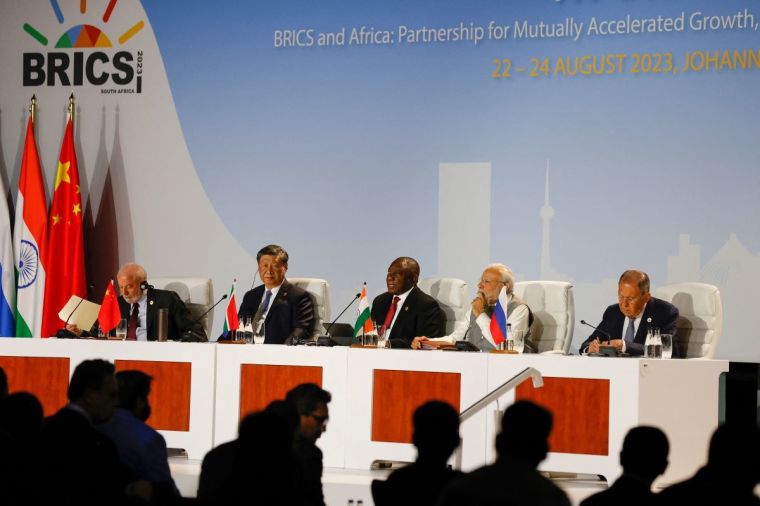
This month, the world leaders of BRICS (Brazil, Russia, India, China, and South Africa) met in South Africa, and their alliance could disrupt the current world order — most significantly, the dominance of the U.S. dollar and the power of Western nations.
The acronym was coined by former Goldman Sachs chief economist Jim O’Neill back in 2001. It started as BRIC, which were some of the largest and fastest growing economies — Brazil, Russia, India, and China. Pleased with the title, these four nations created an alliance and soon added South Africa, which changed their name to BRICS. For the United States and Europe, it was an obscure multi-lateral relationship that didn’t affect us; however, that reality is quickly changing. Just last week six more nations were added to the alliance — Saudi Arabia, United Arab Emirates, Iran, Egypt, Argentina, and Ethiopia, with over twenty more countries vying for membership.
Now, BRICS nations represent 42% of the world’s population, just above 25% of global gross domestic product, and nearly 20% of all trade. Their total GDP and purchasing power are more extensive than that of the G7 by about 2%. With Saudi Arabia and the UAE, they will control 42% of the world’s oil production. Despite their combined capacity, BRICS has only a fraction of the voting power at the International Monetary Fund and very little influence in the World Bank. BRICS nations have set their sites on changing this imbalance with several critical initiatives.
First, the member nations want an alternative to U.S.-led financial institutions, which keeps them beholden to the demands of Western countries. They have founded the New Development Bank, which has approved more than $30 billion in loans since it was established in 2015. Compare that to the World Bank, which committed more than $100 billion in 2022 alone. Though smaller in size, the NDB is continuously growing with cash infusions from member nations and expansion into more countries. Inevitably, the alliance will have billions, maybe trillions, of dollars to advance programs that contravene Western interests. Its commitment to lend in its member’s currencies will further devalue the US dollar and is one step closer to the de-dollarization of trade. NDB funds can also be used to subsidize the production and sale of goods that specifically disadvantage U.S.-made products through unfavorable tariffs and trade agreements.
Most significantly, BRICS also aims to reduce reliance on the U.S. dollar by switching to other currencies. Member countries have expressed their dismay that Washington weaponizes the dollar through its sanctions. Russia and Iran have already experienced crippling economic consequences, while the U.S. threatens to do the same to China. There is even a discussion that BRICS would create its own common currency. Such a move, a single form of digitized, programmable currency, would collapse the U.S. dollar and cause a significant upset in the balance of global power. Moreover, it is not hard to conceive a centralized government power that would emerge due to a unified economic system.
Though much of the discussions about currency were just “ideas” that the U.S. largely ignored, including Saudi Arabia and the UAE, the BRICS alliance gives new weight to the fear of what this all means for the U.S. economy. BRICS is projecting itself as a geopolitical alternative to a U.S.-led world order, representing the Global South.
Saudi Arabia and the UAE seek to deepen cooperation with non-Western countries and diversify their economic partnerships as an additional hedge against the US. Since 1971, Saudi has promised to export its oil only in U.S. dollars in exchange for the military and political protection of the United States. This agreement is largely responsible for the current hegemony of the U.S. dollar in world trade, which is termed the “petrodollar.”
In the first several decades of this partnership, the U.S. gained tremendous influence and wealth from this Faustian bargain. It was a deal with little downside — until the Saudis used their billions to export a virulently anti-American interpretation of Islam. Most politicians, businessmen, and diplomats turned a blind eye to the devastating consequences this ideology had on societies that were once friendly to the West. They sold our standing in the Muslim world for immeasurable wealth. Even though that deal with the devil came home to roost with the attack of 9-11, the bizarre alliance with the Saudis remained a cornerstone of U.S. policy. I know dozens of experts, including myself, who pleaded with policymakers to end or at least redefine the terms of the U.S.-Saudi relationship, but nothing ever changed. As a result, terrorism and the destruction of Western interests continue until today at the hands of Saudi theologians, activists, and politicians — primarily financed by the U.S. military-industrial complex.
Many experts believe the relationship is unbreakable because both countries desperately need each other. Despite the reality that Saudi elementary school kids are taught to despise everything America represents, many assume the Saudis are too weak or incapable of ever genuinely turning against the U.S. Some even believe the lie that Saudi elites promoted radical Islam to appease the masses, and none of them actually believe it.
However, as a student of radical Islamic thought, I can assure you the Saudis have been dreaming of the day their economic power and independence would bring the downfall of the U.S. They may have been too feeble or impotent, but they were always planning it. Their literature spoke of this scheme for decades. Islamic extremists plan in millennia, not months, when U.S. foreign policy is governed by four-year election cycles. The BRICS alliance may represent the perfect opportunity for Saudi Arabia to break the chains of its Master and yield a decisive blow.
Several critics argue that the group’s internal differences will inevitably prevent their success. For example, India and China have a simmering border conflict. While Beijing and Russia are rivals to the U.S., you’ve got India, South Africa, and Brazil, which all would be wary of harming relations with the West. Despite China’s peacekeeping efforts, a deep-seated hatred between Iran and Saudi could flare up anytime.
As a Christian, I find it worrisome that the BRICS alliance comprises almost entirely of non-Christian majority countries. In fact, it is a conglomerate of those who despise the one true God and everything He represents in the world and for humanity. It also reminds us of prophecies foretold in the Bible, how every nation aligns against the people of God.
“The beast was given a mouth to utter proud words and blasphemies and to exercise its authority for forty-two months. It opened its mouth to blaspheme God and to slander his name and his dwelling place and those who live in heaven. It was given power to wage war against God’s holy people and to conquer them. And it was given authority over every tribe, people, language, and nation” (Revelation 13:5-7).
Regardless of your view eschatological viewpoint, we shouldn’t be quick to dismiss how deep the resentment may run for these countries. Many spent centuries under European colonization and blame their current plight on that experience. In particular, we must be very wary of their next move for countries like Iran and Saudi, whose theology breeds an inevitable conflict with the West.
Hedieh Mirahmadi was a devout Muslim for two decades working in the field of national security before she experienced the redemptive power of Jesus Christ and has a new passion for sharing the Gospel. She dedicates herself full-time to Resurrect Ministry, an online resource that harnesses the power of the Internet to make salvation through Christ available to people of all nations, and her daily podcast LivingFearlessDevotional.com.
Free Religious Freedom Updates
Join thousands of others to get the FREEDOM POST newsletter for free, sent twice a week from The Christian Post.




























![[Video] More – Aghogho » GospelHotspot](https://gospelhotspot.net/wp-content/uploads/2024/04/More-Aghogho.jpeg)
















